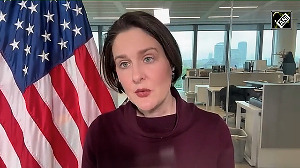Unlike in the past, when old private banks compromised upon underwriting standards to take on the bulk, they’ve now realised that scaling up at the cost of quality isn’t worth the while.
These banks have also readjusted growth targets when required, and rebalanced books to preserve capital and asset quality.
Hamsini Karthik and Raghu Mohan report.
Illustration: Dominic Xavier/Rediff.com

There is a saying in Tamil, which, when translated, means: “One should not live in a place where there are no temples”.
N Kamakodi of City Union Bank (CUB) takes pride in the fact that the bank’s founding place is in Kumbakonam which is called the “Temple City of Tamil Nadu”, in Thanjavur district, the state’s granary.
The 119-year old bank has the bells and whistles to match its metro-centric peers (sans the glamour).
However, its managing director and chief executive officer (MD and CEO) firmly believes that staying connected to one’s roots helps give one the wings to fly high.
“We have taken several measures for the improvement of agriculture - water conservation and desilting activities”, says Kamakodi.
The recent spotlight on old private banks has largely been because of the merger (currently work-in-progress) between Lakshmi Vilas Bank (LVB) and Indiabulls Housing Finance (IHF).
However, there is enough indication that these banks are set to improve their game, with renewed interest from investors.
A digression may be in order, too.
Mint Road has jettisoned the prefix “old” for these banks from its tomes, which shows the distance these banks have travelled over the years.
Catholic Syrian Bank (CSB) is scheduled to go in for its initial equity float within a year.
Last year, billionaire Prem Watsa’s Fairfax picked up 51 per cent stake in CSB for around Rs 1,200 crore.
Federal Bank is still in the hunt for a microfinance company with asset size of at least Rs 3,000 crore, even though MD and CEO Shyam Srinivasan’s attempt to take over Chennai-based Madura Microfinance ended in failure.
It wants to take a leaf out of the IndusInd Bank-Bharat Financial Services deal.
These banks, taking a cue from the recent credit crisis, are reworking their underwriting practices, have centralised a major part of the back-end processes, and have migrated to better technology platforms.
Fee structures are very much in focus, too, given that being asset-light is smarter than blowing up capital, following the likes of an HDFC Bank, an ICICI Bank, or an Axis Bank.
CUB is now a registered mutual fund (MF) distributor on the BSE.
Many seek to co-lend with non-banking financial companies (NBFCs); it helps cut down on the lead-time taken to enter newer regions and clientele.
‘Look at us now’
“The biggest advantage is their regional appeal, which they have been able to preserve over the years,” says Saurabh Tripathi, senior partner and director of the Boston Consulting Group.
“We are strong in western and southern India.
"We understand the social and business nuances in these belts, which is more difficult to understand when you are a huge organisation such as our bigger competitors,” says P R Seshadri, MD and CEO of Karur Vysya Bank (KVB).
Incidentally, the fact that the credit culture in the west and south have traditionally been strong over the decades - evidenced in the roots of these banks and, in particular, the strong co-operative bank movement in these parts - really helps.
On the liabilities side, the dynamics at play in these banks are not very different from their new-generation peers.
For instance, term deposits are largely retail in nature, even though the share of current and savings accounts is significantly lower at 25-35 per cent, when compared to the 40 per cent-plus of HDFC Bank, or for that matter even lower than that of ICICI Bank or Axis Bank.
At the systemic level, reliance on wholesale funding is gaining steam on account of the savings plans of MFs and insurance firms.
However, the blowout at Infrastructure Leasing & Financial Services and its contagion effect on MFs means the current trend of disintermediation will stand arrested, to an extent.
On the asset side, the reluctance on the part of few NBFCs to lend, and many state-run banks remaining under Mint Road’s prompt corrective action framework, means old private banks are in a sweet spot on this front as well.
Further, 30 per cent or more of their loans are to small and medium enterprises (SME); their grip over the regions they operate in allows them to retain dominance in this segment.
While this strategy carries the risk of making them vulnerable to a slowdown in textiles, rubber, or industrials, this has nevertheless been reduced by focusing on home, vehicle, gold and education loans, to capture a wider retail lending spectrum.
Besides, they’ve built processes that are more system-driven and less manual.
Unlike in the past, when old private banks compromised upon underwriting standards to take on the bulk, they’ve now realised that scaling up at the cost of quality isn’t worth the while.
Moving too fast and too soon affected Dhanlaxmi Bank under the leadership of MD and CEO Amitabh Chaturvedi.
These banks have also readjusted growth targets when required, and rebalanced books to preserve capital and asset quality.
Kamakodi says: “Our loans to SMEs are additionally collateralised by residential property and personal guarantees.
"We are predominantly into single-banker relationships, with minimal exposure to consortium and multiple-banking arrangements, or to the infrastructure sector.”
An equally important change that has happened over the years is that the hold of promoters and instances of corporate interest have markedly reduced in such banks.
A case in point is when the Reserve Bank of India read out the riot act in September 2007 to Raja Mohan Rao, a businessman from Andhra Pradesh who held 36.69 per cent in Dhanlaxmi Bank.
The clean-up led to investments by WCP Mauritius Holdings (Wolfenson Capital Partners), Customers Bancorp, and MKCP Master Holdings II (Mount Kellet Capital Partners).
There is also the case of the Ruias of Essar making an abortive bid for Tamilnad Mercantile Bank in the mid-1990s.
In turn, it has given rise to the perception that old private banks are ripe acquisition candidates after a string of deals in the subsequent years - ING Group’s 44 per cent stake in Vysya Bank in 2002; United Western Bank-IDBI Bank (suitors included HDFC Bank, ICICI Bank, Citibank, Standard Chartered Bank, and even Udayan Bose, then head of Lazard Capital) and Sangli Bank-ICICI Bank (both in 2006); and Lord Krishna Bank-Centurion Bank of Punjab (2007), which later came to reside within HDFC Bank.
After a deal hiatus of many years, it might be tempting to believe that the narrative has changed after the LVB-IHF deal announcement.
Priced at a 36 per cent premium in favour of LVB, the jury may be out on if this is justifiable, but what you can’t get away from is - this is valuation you have on the table as on date.
Sure, stress affects price discovery.
For LVB, the struggle to raise Rs 2,000 crore of capital tempted it to take up the offer from IHF.
Such a proposition may also lure Dhanlaxmi Bank, given its capital position, but zeroing in on names beyond these will be challenging. Further, these banks value their identity.
LVB’s MD and CEO Parthsarathi Mukherjee says: “The bank can’t give away its 92-year old identity.
"It can cut both ways - be a deal-breaker even as it drives valuations!”
Seshadri adds: “We aspire to be an HDFC Bank or and ICICI Bank in our own way.”
It’s not only Kamakodi’s CUB; no old private bank is Godforsaken!












 © 2025
© 2025